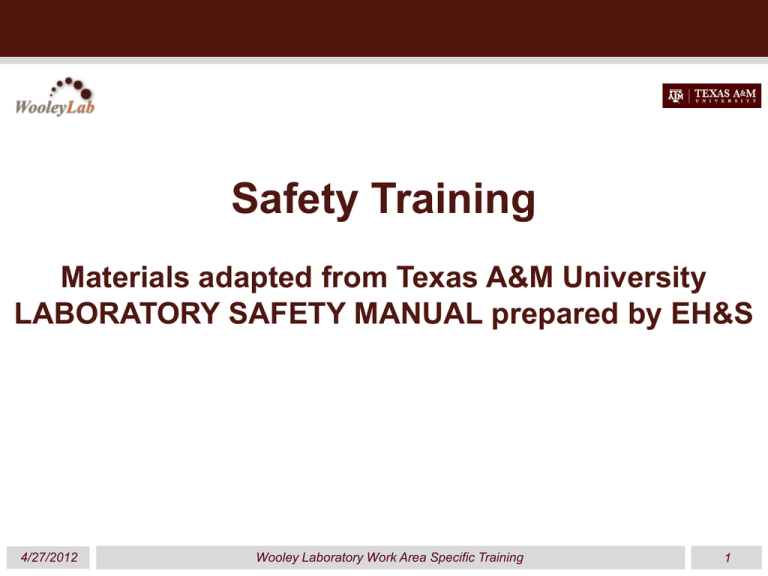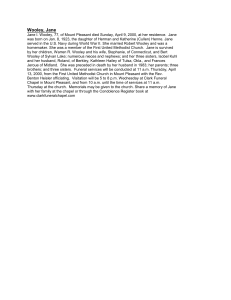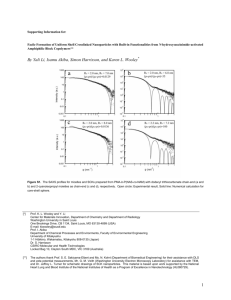Safety Training Materials adapted from Texas A&M University
advertisement

Safety Training Materials adapted from Texas A&M University LABORATORY SAFETY MANUAL prepared by EH&S 4/27/2012 Wooley Laboratory Work Area Specific Training 1 Outline 1. 2. 3. 4. 5. 6. 7. 8. 9. 10. 11. 12. 13. PPE Clean areas Instrument labs Chemicals Gas cylinders Centrifuge Waste Broken glass disposal Sharps disposal Laser Showers, eyewashes, fire extinguishers, spill kits, etc. Emergency evacuation Additional information All Wooley Group members must read and understand this document before working in any of the Wooley Group Labs (Chemistry Building Wing ’72 rooms 1405, 1405A, 1411, 1413, 1417, 1417A, 1417B, 1430 and 1432). 4/27/2012 Wooley Laboratory Work Area Specific Training 2 Wooley Group Blue Book Outline • • • • • • • • • • • • • • • Appendix 1: TAMU Lab Safety Manual Appendix 2: General Safety Appendix 3: Fire & Life Safety Appendix 4: Personal Protective Equipment Appendix 5: Chemical Safety Appendix 6: Chemical Compatibility Chart Appendix 7: Recommendations for the Safe Handling of Cytotoxic Drugs Appendix 8: Electrical Safety Appendix 9: Office Safety Appendix 10: Wooley Laboratory Safety Evaluation Appendix 11: Laboratory Safety Evaluation Codes (checklist) Appendix 12: Work Area Specific Training Appendix 13: Hazards Communication Training Record Appendix 14: Emergency Response Team Appendix 15: Interim Guideline for Working Safely with Nanotechnology Blue book located in 1430 above contact angle instrument 4/27/2012 Wooley Laboratory Work Area Specific Training 3 Work Area Specific Training • Appendix 12: Work Area Specific Training I. Personal Protective Equipment II. Clean Areas III. Use of Volatile Organic Chemicals, Corrosives, Flammable Materials, and Toxins IV. Use of Peroxide Forming Chemicals (ethers, picric acid, etc.) V. Use of a Chemical Fume Hood VI. Use of Gas Cylinders VII. Use of Centrifuge VIII. Use of Carcinogens IX. Use of Lasers X. Reproductive Toxins/ Reproductive Protection XI. Highly Toxic Materials/Select Agents XII. Biology Room (Room 1417A) XIII. Instrument Labs (Chemistry Building Wing ’72 rooms 1405A, 1417, 1417A, 1430, 1432) XIV.Inspections XV. Hazardous Waste XVI.Chemical Storage 4/27/2012 Wooley Laboratory Work Area Specific Training 4 Appropriate Usage of PPEs Safety glasses Face shield Respirator Dust mask NOT to be worn out of the lab Lab coat Hands should be washed between glove changes and after glove removal Benchtop safety shield • Personal protective equipments (PPEs): Gloves Close fume hood sashes when not in use. A single fume hood running 24 hours can use as much energy as a single-family home uses in a year. 1)Include arms & hand protection, body protection, hearing conservation, eye & face -Vanderbilt Univ. ThinkOne Energy Conservation protection, foot protection, head protection, 1) The fume hood should not be used respiratory protection, Long pants/skirt 2)Should be used in conjunction with engineering, administrative or procedural controls as a storage area for chemicals or equipment unless designated as such by Professor Wooley with approval from EH&S 2) All containers must be capped when 3)Should always be removed before coming not in use in contact with other individuals or before going in/out or near elevators, break rooms, 3) Work at least 6” inside the hood with Closed-toe, classrooms, office rooms, bathrooms, a sash opening of 12 to 15 inches non-porous shoes touching door knobs, etc. 4/27/2012 Wooley Laboratory Work Area Specific Training 5 Specific PPE Face shield Respirator Dust mask • Everyone requiring a face shield or respirator must be properly fitted prior to purchase. • The appropriate cartridges must be worn for specific tasks. • Cartridge usage must be documented, and cartridges must be discarded after 8 hours of use. • If you are unsure which cartridge to use or for other assistance, ask Adriana Pavia. • Respirator may not be shared for any reason. • Dust masks are in the bulk area in 1413 and must be worn when handling silica gel. Further use at user discretion. 4/27/2012 Wooley Laboratory Work Area Specific Training 6 Hygiene & Chemical Safety • Good personal hygiene will help minimize exposure to hazardous chemicals. When working with chemicals, follow these guidelines: 1.Wash hands frequently and before leaving the laboratory. Also, wash hands before eating, drinking, smoking or applying makeup. 2.Wear appropriate personal protective equipment (PPE). Always wear protective gloves when handling any hazardous chemicals. 3.Remove PPE before leaving the laboratory and before washing hands. 4.Remove contaminated clothing immediately. Do not use the clothing again until it has been properly decontaminated. 5.Follow any special precautions for the chemicals in use. 6.Do not eat, drink, smoke or apply makeup around chemicals. 7.Tie back long hair when working in a laboratory or around hazardous chemicals. 8.Do not keep food, beverages, or food and beverage containers anywhere near chemicals or in laboratories where chemicals are in use. 9.Do not use laboratory equipment, including laboratory refrigerators/freezers, to store or serve food or drinks. 10.Do not wash food and beverage utensils in a laboratory sink. 11.Do not sniff or taste chemicals. 12.Do not touch door knobs, telephones, computer keyboards, etc. with contaminated gloves. 4/27/2012 Wooley Laboratory Work Area Specific Training 7 Clean Areas A. The break room (room 1424) and all the office spaces (rooms 1421 and 1421A, 1422 through 1429) are considered clean areas. B. PPE such as lab coats and gloves are not to be worn in clean areas C. Absolutely no chemicals are to be used or stored in the clean areas D. No food or drink is allowed in non-clean areas, and no food or drink is allowed to be stored in any refrigerator with a “No Food or Drink” designation 1432 1431 4/27/2012 1430 1429 1428 1427 1426 1425 1424 Wooley Laboratory Work Area Specific Training 1423 1422 1421A 1421 8 Instrument labs XIII. Instrument Labs (Chemistry Building Wing ’72 rooms 1405A, 1417, 1430, 1432) A. All instruments and instrument computers are glove free areas B. Samples are not to be prepared in the instrument labs C. No compounds that fall into the following hazard classes are to be used in the instrument labs unless given express permission from Professor Wooley (Inhalation hazards, Unstable explosives, Highly toxic solids/liquids) 4/27/2012 Wooley Laboratory Work Area Specific Training 9 Bio-hazard Lab XII. Bio-lab is located inside 1417 (1417A) A. Bio-safety level 2 (BL2) training is required to use and enter this room B. BL2 training is offered by the university and record of training must be submitted to Judy C. Further questions about bio safety should be addressed to Dr. Mahmoud El Sabahy 4/27/2012 Wooley Laboratory Work Area Specific Training 10 General Chemical Safety Once logged into inventory systems, all chemicals are marked with a received date, open date must be written on bottle Improper dating of chloroform: Chloroform should be used within 1 year of purchase or 6 months of opening because it can form phosgene gas. Dispose of any unused chloroform once these time limits have passed Improper dating of peroxide-forming or oxidizing chemicals (ethyl ether, THF, perchloric acid, cyclohexene, butadiene, isopropyl ether and dioxanes): Explosive peroxide forming chemicals and oxidants such as ethyl ether, THF, perchloric acid, cyclohexene, butadiene, isopropyl ether and dioxanes must be used within 1 year of purchase or 6 months of opening and must be disposed of before the expiration date VIII. 1. 2. 3. 4. 5. 6. Use of Carcinogens (See Appendix 1, 3-18) Use a fume hood (or controlled area like a glove box) and wear all appropriate personal protective equipment Vent vacuum pumps into the fume hood if being used with a carcinogen Decontaminate any glassware in your fume hood Dispose of carcinogens in an appropriate container and use secondary containment for storage and transportation of waste Store in an area with limited access in a fully labeled, non-breakable secondary container If working with a known carcinogen regularly (i.e. three or more times per week) you must consult the chemical safety officer, Professor Wooley, and an EH&S representative about medical surveillance 7. Should a spill occur, contact EH& S and be sure that exposure of people and property to the carcinogen is limited. 8. Remove all protective equipment and dispose of gloves etc. in a proper manner and wash hands, neck and face prior to leaving X. Reproductive Toxins/ Reproductive Protection A. All group members are responsible for knowing the reproductive hazards of the chemicals they are directly working with B. All reproductive toxins must be handled in a hood C. Any member who is pregnant or is considering becoming pregnant should notify Professor Wooley and discuss appropriate measures to limit their exposure to reproductive toxins 4/27/2012 Wooley Laboratory Work Area Specific Training 11 Use of gas cylinders a. Never move a gas cylinder unless the cylinder safety cap is in place. b. When working with particularly hazardous gases use special procedures and work in approved gas storage cabinets. c. The gas cylinder should be chained or otherwise secured to an approved cylinder cart or dolly when being transported. Do not move a cylinder by rolling it on its base. d. Only use regulators approved for the type of gas in the cylinder. Do not use adapters to interchange regulators. Also, never try to repair or modify a gas regulator or its pressure gauges. e. Do not use Teflon tape when attaching the regulator. f. When opening a cylinder valve, follow these guidelines: i. Direct the cylinder opening away from people. ii. Open the valve slowly. Never open a cylinder valve without a regulator. g. For a leaking cylinder: i. Close the valve if it is open and contact the supplier to pick it up. ii. If the valve is already closed, leave the laboratory and shut the door behind you. Contact EHS immediately. h. Do not use oil or other lubricant on valves and fittings. i. Do not use oxygen as a substitute for compressed air. j. Do not lift cylinders by the safety cap. k. Do not tamper with the safety devices on a cylinder. Have the manufacturer or supplier handle cylinder repairs. l. Do not change a cylinder's label or color. Do not refill cylinders yourself. m. Do not heat cylinders to raise internal pressure. n. Do not use compressed gas to clean your skin or clothing. o. Do not completely empty cylinders. Maintain at least 30 psi pressure. p. Do not use copper (>65% copper) connectors or tubing with acetylene. Acetylene can form explosive compounds with silver, copper, and mercury. q. Always wear impact resistant glasses or goggles when working with compressed gases. r. Do not subject compressed gas cylinders to cryogenic temperatures. 4/27/2012 Wooley Laboratory Work Area Specific Training 12 Use of Centrifuge A. Use sealed cups for carcinogenic or infectious agents B. Do not open the centrifuge until it has completely stopped spinning C. Do not centrifuge odd number of tubes, always balance single Fisher Scientific tubes with a tube of similar weight containing an inert substance Sorvall ST 16R (preferably water) D. Wait 5-10 minutes after the run is complete before opening the lid. This will permit any aerosols generated to settle 2 4/27/2012 3 Wooley Laboratory Work Area Specific Training 4 6 13 Proper Waste Disposal XI. Highly Toxic Materials/Select Agents A. Avoid use of highly toxic or select agents whenever possible B. Discuss use of highly toxic or select agents with Professor Wooley before use C. Purchase the minimal amount of highly toxic or select agents possible D. Consult EH&S before disposal Water waste needs pH Dialysis water should be disposed in waste bottle if using carcinogens or other dangerous chemicals XV. Hazardous Waste A. All hazardous waste containers must be labeled with a complete Hazardous Waste Disposal Tag from the date that the container is first used B. Hazardous waste must be stored in a container that is compatible with the waste, is fully closeable and is in good repair C. All hazardous waste containers that are to be sent out for disposal are to be placed in the designated waste hood in each lab D. After 11 months of use all hazardous waste containers must be sent for disposal E. Non-biohazard sharps are to be collected in an approved sharps container with a completed hazardous waste label F. Any questions regarding hazardous waste streams should be directed to EH&S before the waste stream is started to ensure compliance 4/27/2012 Waste Bottles Need to Be Defaced and Tagged. After defacing bottles, inventory tag must be removed and chemical must be logged out of system or tag placed in boxes for future removal Do not fill past shoulder Wooley Laboratory Work Area Specific Training 14 Labeling Waste Karen Wooley Chemistry X-XXXX Water, methanol, tetrahydrofuran Karen Wooley Chemistry X-XXXX Lab supplies contaminated with … 04/26/2012 Karen Wooley Chemistry Chemistry building 72 wing 14XX X-XXXX Water, methanol, tetrahydrofuran 04/26/2012 Karen Wooley Chemistry Chemistry building 72 wing 14XX X-XXXX Lab supplies contaminated with … Weight of waste Plastic bag 4/27/2012 Wooley Laboratory Work Area Specific Training 15 Broken glass disposal • Glassware contaminated with biological agents, chemical or radiological materials must be decontaminated prior to disposal • If decontamination is not possible, the glass should be disposed of as hazardous or radioactive waste • If broken glass is commingled with metal sharps, it must be treated as sharps waste and encapsulated before for disposal • FAQ: Old/unwanted/almost empty bottle of chemical that cannot be washed: Give it a separate waste tag and treat it as a liquid/solid waste bottle •Large glass disposal boxes will not be taken down by custodial staff, you must take them to the dumpster for disposal 4/27/2012 Wooley Laboratory Work Area Specific Training 16 Metal sharps disposal • Sharps that have been used with chemical or biological materials should be decontaminated whenever possible prior to disposal • Needles must be capped or covered (melting parafilm, etc.) prior to disposal • When the container is ¾ full, encapsulate the sharps with Plaster of Paris (calcium sulfate hemihydrate, stockroom ID 025912, CAS 10034-76-1) or some other solidifying medium. Once the contents are encapsulated, seal the sharps container, label it “Encapsulated Sharps,” and take it to the dumpster 2 CaSO4·½H2O + 3 H2O + needles → 2 CaSO4·2H2O + needles 4/27/2012 Wooley Laboratory Work Area Specific Training 17 Lasers IX. Use of Lasers A. “Laser in Use” signage must be turned on whenever lasers that are not shielded are in use B. Wear appropriate laser shielding eyewear at all times when working with the laser C. Restrict access to lasers whenever they are on Innova 300 Laser group job person needs to complete the following: Laser safety training (by EH&S) Laser permit verification (renew annually) Examples Warnings Precautions Class 4 (most hazardous) Innova 300 Avoid eye or skin exposure to direct or scattered radiation “LASER IN USE” Laser protective eyewear Laser curtains Class 3b Delsa Nano C when open and interlocks defeated Avoid direct eye exposure Not applicable Class 3a Laser pointer Do not stare into beam Class 2 Barcode scanner ? Class 1 (least hazardous) Delsa Nano C none 4/27/2012 Wooley Laboratory Work Area Specific Training 18 Emergency shower Emergency shower/eyewash Showers, Eyewashes, Fire Extinguishers and Spill Kits 4/27/2012 Acid spill neutralizer - sodium bicarbonate, sodium carbonate, or calcium carbonate. Base neutralizer - sodium bisulfate. Solvent absorbent - Inert absorbents such as vermiculite, clay, sand, Flor-Dri, and Oil-Dri. swivel eyewash station Requires a weekly testing + recording by a group member Acid, caustic, solvent, mercury spill kits A. All eye washes must be inspected once a week by a Wooley group member for operation and accessibility and inspection dates recorded in the Emergency Eyewash Station Weekly Activation Log. B. All fire extinguishers are inspected once a month by designated EH&S personnel for operation and accessibility C. Safety officers should conduct “Peer Audits” on a periodic basis and report findings to Professor Wooley and the group at group meetings Fire classes Fuel/Heat Source Class A Ordinary combustible Flammable liquids Class B Flammable gases Class C Electrical equipment Class D Combustible metals Class K Cooking oil or fat [P.A.S.S.] Pull, Aim, Squeeze, Sweep • May request a demonstration & practice session if desired Fire extinguisher for B & C fires Wooley Laboratory Work Area Specific Training • inspected by EH&S 19 Showers, Eyewashes, Fire Extinguishers and Spill Kits Store waste only in Waste O R W O I B W R R B I R W E B E E E E E E E E S/E E S/E S/E 1411 1405 E 1413 1417 BB E S/E CaSO4·½H2O BB Blue book S/E E I O B W Inorganic acid Organic acid 12 eyewash stations 2 emergency shower stations Base 4 shower/eyewash stations Waste R Reactive 4/27/2012 8 fire extinguishers 1 set of spill kits Wooley Laboratory Work Area Specific Training 20 Emergency Exit Routes 4/27/2012 Wooley Laboratory Work Area Specific Training 21 Ireland St. Emergency Evacuation: Assemble & Report to Judy 4/27/2012 Ross St. Wooley Laboratory Work Area Specific Training 22 Additional information ehsd.tamu.edu Chemical Inventory Emergency Preparedness Fire and Life Safety Hazardous Material Shipping Hazardous Waste Management Laboratory and Chemical Safety Personal Protective Equipment Call any one of the EH&S personnel and ask questions & interact Ca. four proactive & responsible group members with high speed of execution should be in charge of safety 4/27/2012 Wooley Laboratory Work Area Specific Training 23

